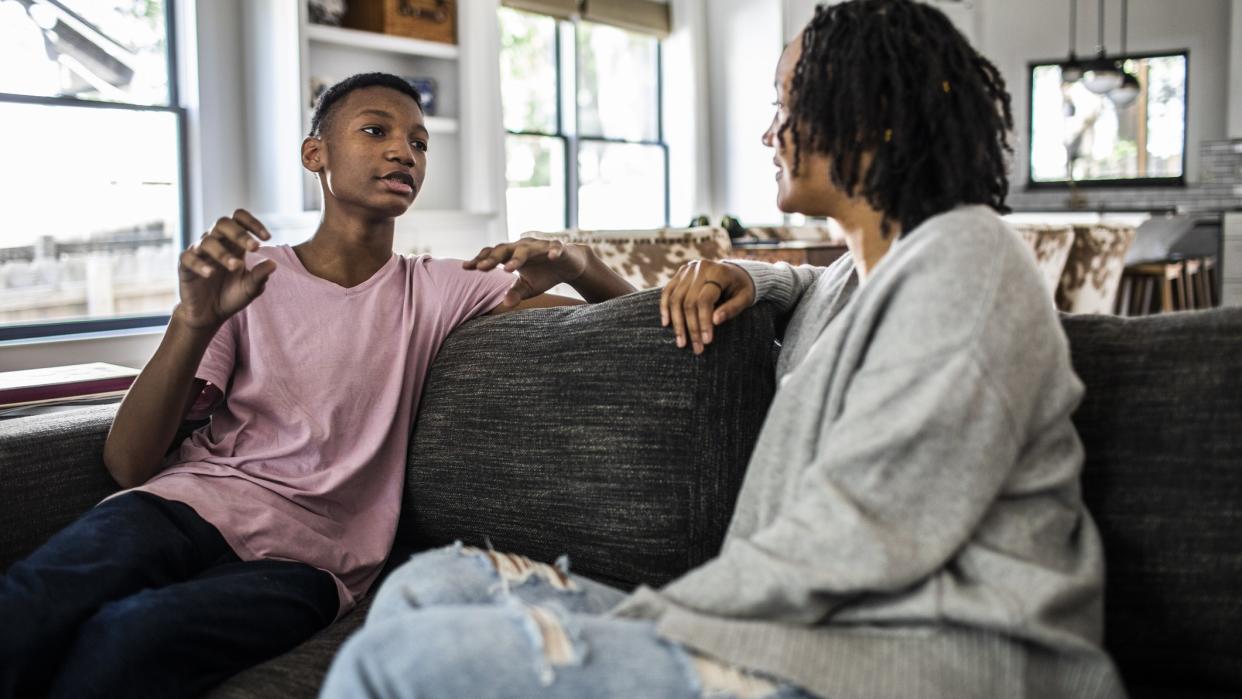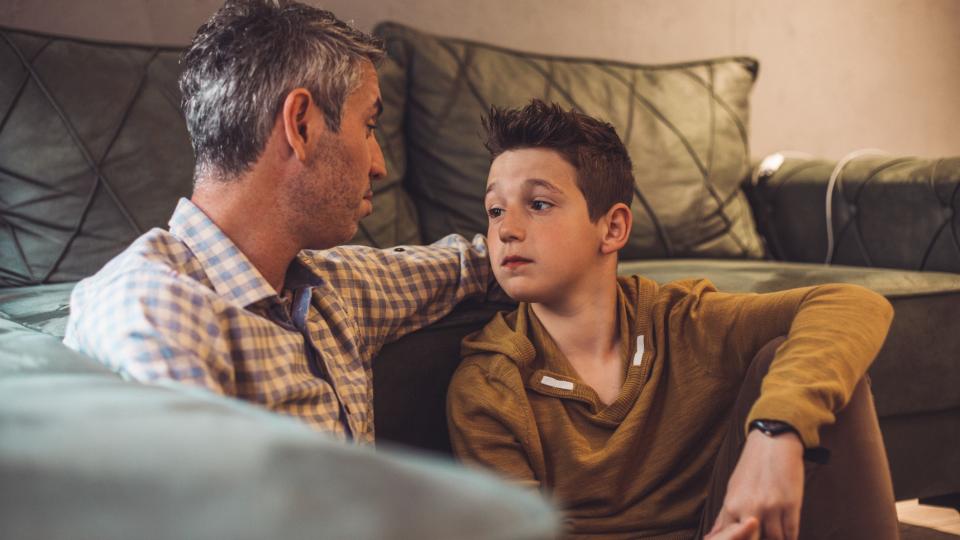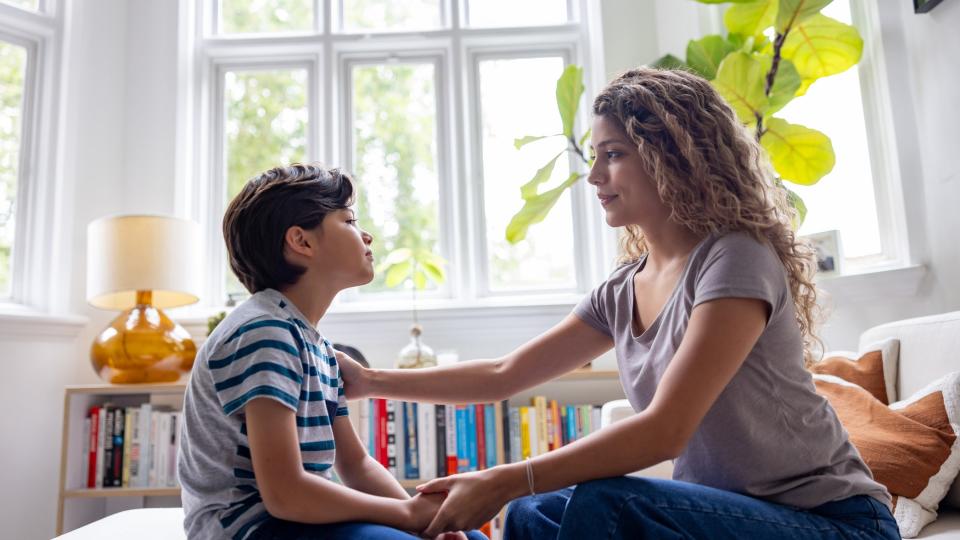What is active listening and how can it improve your relationship with your child? We ask four experts (because it's harder than you think)

Have you ever had an entire conversation with your child without really listening to what they're saying? It's not just you. All parents struggle to truly listen, all the time, to their kids. But practising active listening can dramatically transform how we connect with them and help their social, emotional and cognitive development.
Whether you want to raise resilient kids, teach your child emotional intelligence or find out how to raise a confident kid, active listening is key to strengthening these characteristics, and we're not the only ones who think it. "Active listening is crucial," says psychologist Dr Deborah Gilman. "Maintaining eye contact, summarising what you hear, and avoiding interruption shows respect and encourages your kids to open up. Modelling what good listening looks like not only encourages them to listen in return but strengthens your bond."
We'll guide you through every aspect of active listening and its benefits, not just for your bond with your child but for all your relationships.
What is active listening?
Active listening is a communication skill that requires you to be present and focused on what your child is saying. You're not just listening so you can respond to your child; you're listening to understand what they're saying. It sounds simple, and it is, but it can be hard with the distractions of everyday life and our tendency, as parents, to want to 'fix' things or impart knowledge to our kids.
The Center for Parenting Education (CPE) describes active listening as "the single most important skill you can have in your parenting 'toolbelt'".
With normal (what experts call 'passive') listening, we listen just to hear the content. Active listening requires effort; you need to pay attention to how and what is being told to you and interpret body language, attitude and emotion (these are known as non-verbal cues).
By asking open-ended questions, maintaining eye contact, summarising and reflecting on what your child has said back to you, and withholding judgment, you're showing your child that they are understood and that you are with them in this moment.
Active listening can be applied to toddlers, children, teenagers, and even adults - we're never too old to be listened to. Whether your 3-year-old complains that his sister stole his favourite toy or your 17-year-old worries about their friends leaving them out, active listening can help them to feel valued and heard. Counsellor Rashad Mills says it's particularly useful for teens and can help them listen to you in return. "When teenagers feel heard and feel their opinions are valued, they are more receptive to listening."
How can you try active listening with your child?
There are seven different techniques involved with active listening - don't worry - you don't have to try them all at once, but including just a few of these techniques can help your child feel heard:
Be fully present for the conversation
Pay attention to what they're not saying
Maintain good eye contact
Ask open-ended questions
Summarise and repeat back what they've said
Allow pauses
Don't judge them
1. Be fully present for the conversation
Being fully present means putting away all distractions. So put away your phone, stop making dinner and try to silence any internal thoughts and feelings. Try to avoid being distracted by other things, such as another one of your kids making noise or your phone buzzing.
If there's an emergency that requires your attention, tell your child that what they're saying is important to you and that you'll talk about it more once you've dealt with the other situation. Simply listen to the words your child is speaking. It's harder than it sounds, but it gets a lot easier with practice.
2. Pay attention to what they're not saying
Body language, tone of voice and attitude can sometimes point towards the opposite of what your child is saying. For example, your teenager is talking about a bad mark on a test as though they don't care, but they're talking rapidly, twiddling their fingers or trying not to make eye contact with you. Paying attention to these non-verbal cues can show that they're much more upset or worried about it than they're telling you but feel embarrassed to say that to you explicitly.
We're not the only ones paying attention to nonverbal cues—our kids also look out for signs to measure how much we're actually listening to them. It's important to communicate the right signals, so open up your posture (no folded arms or legs), lean towards them and get down to their level by sitting next to them or kneeling.
"Almost every teen I have worked with complains that their parents 'don't listen' - even when they are!" says therapist Renée Zavislak. "Feelings of invalidation and insignificance are easy to access for the burgeoning teen personality, and for this reason, we need to make sure we give our teens' (sometimes endless rants) our full attention. That means not listening while scrolling or working, making eye contact, and reflecting on what you hear. Where teens often complain that parents don't listen, parents often complain that their teens don't talk to them. If you want them to tell you, make sure you act like you want to hear it!"
3. Maintain good eye contact
While in conversation, look directly at your child when they're speaking. This shows them that they are the most important focus to you right now. That doesn't mean you need to stare them down, though. Some children won't like a lot of eye contact! Experts suggest maintaining eye contact for around 50% to 70% of the time instead. That's holding eye contact for maybe four or five seconds before looking away briefly, then returning your gaze.
4. Ask open-ended questions
In order to keep the flow of conversation going, it's important to ask open-ended questions instead of 'yes or no' questions. Open-ended questions show your child that you're interested in their opinion, rather than just wanting an answer. Here are some examples of open-ended questions that you can use in almost every conversation:
Where would you like to begin?
Would you tell me more about that?
How did that make you feel?
What made you think of that?
Why do you think that happened?
What would you change if you could?
What might help you feel better?
How do you see things changing?
What do you want to do next?
A post shared by Monterey Bay Charter School (@monterey_bay_charter_school)
A photo posted by on
There are many more examples of open-ended questions, from those suitable for preschoolers to teenagers. Search for examples you think might fit your child's age and go from there. In the meantime, here are some great resources:
5. Summarise and repeat back what they've said
It's important to show that you've taken on what your child has said and understand it. If they're complaining that you won't let them go to the cinema with their friends, answer with, "What I am hearing you say is that you want a chance to spend time with your friends and being unable to do that frustrates you.' Then, the discussion can move forward, and you both can reach a solution. This technique also allows your child to correct you and to tell you, "No, that's not it at all." Then you can try again.
You don't need to repeat every word. Just summarise what you think they're saying and keep it simple. Don't focus on small details - hold the bigger picture in mind.
"Try to listen without interjecting and then practice repeating back what you hear," says therapist Rachel Goldberg. "This is important to do, even if you don't agree with what your child is saying, It sends the message that you're listening and doing your best to understand their position on the matter."
6. Allow silence and pauses
Yep - this can be tough! It's actually quite hard to sit in silence with someone, especially a child. Try to stifle your urge to fill gaps in the conversation. So that means allowing your child to speak without interruption until they are finished, then taking a moment to process what they're saying to you.

This approach shows them that you are paying attention to them instead of getting carried away in your own thought processes, or rushing to get somewhere else. It also slows the pace of conversation and gives your child more time to respond honestly.
7. Don't judge them
Another tricky one here, and it takes quite a bit of self-awareness. However, by withholding judgment and staying neutral, you're showing your child that they're in a safe space where they won't be criticised, told off or told what to do. This will help them to feel comfortable and open up to you.
Allowing your child to fully engage and discuss with you is important for their development and your relationship.
The benefits of active listening
Relationship-building
Freedom of expression
Mutual respect
Slower conversations = greater confidence
1. Relationship-building
Active listening builds a sense of trust, support and empathy between parent and child. You can develop effective patterns of communication with your child from an early age, which will be an important base of your relationship once they turn into teenagers and tend to close off from you more.
2. Freedom of expression
Kids tend to feel less controlled by their parents and more supported through active listening. Even though it seems like your responsibility as a parent to educate and lecture your kids on what you've learned through your life experience, sometimes it can be more beneficial to refrain from bringing your own opinion into discussions and simply listen and interpret.
3. Mutual respect
In time, children could become more open to hearing your opinion because you haven't imposed it on them over and over again, meaning they don't associate your opinion as overshadowing theirs and feel more free to express themselves.
4. Slower conversations = greater confidence
Just as we do, children gain a lot by working things out as they speak. By allowing them to have the space to speak about anything, the conversation will slow down as they become the main contributor.
Often in discussions, when two or more people are speaking a lot, it becomes almost like a competition of who can get out what they need to say the most. By avoiding this, your child can develop their self-confidence and independence by reaching their own conclusions through extended speech, without you having to spell it out for them all the time.

Slower conversations can also lower your child's stress levels, as they often require more time than we do to process their emotions and thoughts, and need to think a bit harder to express themselves.
Are there any drawbacks to active listening?
According to the CPE, parents can find active listening quite difficult for different reasons:
'Having your own agendas for how you want situations resolved'
Feeling 'uncomfortable when your children are experiencing something unpleasant'
Having difficulty 'separating your feelings from theirs'
The main drawback is parents having to try and adjust to this method, as it requires effort to tailor it to you and your family's needs. Time is also an issue, as this practice can often be more time-consuming than trying to wrap up the conversation as quickly as possible.
But it's also important to consider the benefits to your relationship with your child and to your relationship overall.
Featured experts
If you struggle to connect with your teenager, here are 25 brilliant ways to open up a conversation with them, with plenty of advice from our experts. Plus, here are the five most important things you should talk to your teen about before they start dating, and what to do if your teenager is drawn to taking risks.

 Yahoo News
Yahoo News 
